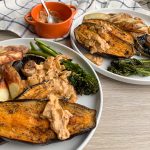
When it comes to travelling with dietary requirements I have got you covered! Before we get started you guys should know that my two favourite things to do are eat and travel. With that in mind I’m sure you can imagine how worried I was that seeing the world would never be the same for me once I had to go gluten free.
After a few years and my fair share of mishaps I began to work out which processes and tricks were invaluable to guarantee, not only an enjoyable trip, but my health and wellbeing while we were away. Over time I really discovered what works for me and found that, gradually, holidays and trips on a gluten free diet became no trouble at all. Surprisingly once I gave up meat I barely even noticed a difference in the challenges faced when travelling and even managed three weeks in Tanzania with no issues. At the time of writing this I have recently returned from my first holiday as a gluten free vegan and, although this did result in food choices being a lot more limited, the fundamentals of ensuring a safe and fun trip remained the same.
In this guide on travelling with dietary requirements I will walk you through what to do before and after booking your holiday, additional things to pack, how to successfully navigate airports, ways to make your self catering experience easier and what to do once you arrive at your destination. I know it might be tempting to just skip ahead to the section you need BUT it honestly is worth taking a few minutes to read the entire post just in case there is something you haven’t thought of when it comes to travelling with dietary requirements.
Before You Book
First of all, you need to do your research! Choosing a hotel that can accommodate you and is set in a location full of restaurants that are clued up on allergens will make your life so much easier. Something as simple as having gluten free bread available to you at the all inclusive breakfast buffet, (and the chefs having an awareness of how to safely store it to avoid cross contamination), will go a long way in making your break more enjoyable.
Once you know which country or area you want to visit start googling hotels and looking at their reviews online. I find the quickest and most reliable way to do so is to head over to TripAdvisor and just type ‘gluten free,’ (or whichever dietary requirement is relevant to you), into the search bar. This will allow you to see what the experiences of others who have been travelling with dietary requirements have been like. It is important to pay attention to whether or not the reviews are recent as this will affect their reliability. For example, I went to the Dominican Republic in 2019 and had a brilliant stay, I was met at check in to talk about my dietary requirements and was assigned a restaurant manager who made me feel very safe and organised gluten free pastas and pizzas for me. However, since reopening this year the reviews on the hotel’s ability to cater for gluten free have all been terrible so, presumably, I would not receive the same treatment if I went now.
If TripAdvisor and Google reviews are coming up short you could always just email the hotel and enquire about their ability to cater for you. Make sure you ask about their procedures when it comes to cross contamination as well as whether they have specific free from products available and correct labelling on their menus. If the hotel staff are made aware of your requirements in advance they will be better equipped to accommodate you and most large hotels will likely arrange to meet with you on arrival to plan your meals for the duration of your stay.
Shopping around, doing your research and speaking to the staff in advance to ensure that they can accommodate you is invaluable when it comes to travelling with dietary requirements! The same goes for any cruises, guided walking tours etc. you may be planning on doing. I’ve been on cruises where I’ve had entire loaves of bread made for me each day and on a week-long walking tour where I had gluten free pancakes every morning! I promise you that these places do exist and it is worth basing your trips away around them.
Before You Go
If you are anything like me you will want to get out, explore your surroundings and eat out at a couple of restaurants while you’re away. This means that you now need to research local restaurants that can cater for you to make travelling with dietary requirements as simple as possible. As we all know, having dietary requirements can make eating out incredibly stressful as we can’t just stroll into the first place we see that looks cute and has a nice view of the ocean.
You need to do some research in advance and I find the easiest way to find local restaurants that can cater to your needs is to simply google the destination alongside your dietary requirements and see which ones come up. From there you can check the menus and, you guessed it, head back over to your new best friend TripAdvisor. Jokes aside, TripAdvisor really is a useful tool as you can just make your way through your list of restaurants and type your dietary requirements into the search bar. We have to remember just because a restaurant states ‘gluten free options’ on their website does not mean they are actually knowledgeable when it comes to cross contamination or are able to serve you more than a dry jacket potato. Reading reviews from other people who have visited the restaurant is the fastest way to find out whether it is worth a visit.
Again, if google is coming up short, do not be afraid to email the restaurant to enquire about their ability to cater for you, including their cross contamination procedures and whether they have separate fryers. I’m sure at home you would ask lots of questions so keep that same energy when preparing to leave the country. You might feel like you’re inconveniencing them with your interrogation, however, it will take them a lot less time to type a response than it will for you to recover from a reaction.
Once I have my list of restaurants that are able to cater for me, I then like to work out roughly whereabouts they are in comparison to my hotel and nearby attractions so that, no matter where I am, I know the closest restaurant that can feed me. I think this is especially useful to do if you’re heading out on a city break and your days are going to be crammed full of sightseeing! I have even been known to add the restaurants onto maps of the city, however, I admit this might be a little bit extra and just writing the addresses in your phone is probably as effective. It may also be worth taking note of any large chain restaurants you spot as most of them will have a gluten free and/or vegan menu if you get desperate.
One thing that can cause a lot of worry about travelling with dietary requirements is the language barrier and the miscommunication that it can cause. If you have coeliac disease you can access amazing gluten free restaurant cards in a variety of languages from CeliacTravel.com that will explain your needs in the language of the country you are visiting which, in my opinion, makes travelling with dietary requirements much easier. You can download these to your phone or print them off and just show it to the server before you are seated.
Alternatively, if you have quite a while until you’re due to travel you could even try to learn a little bit of the language so you are able to communicate your needs. It was actually in the Dominican Republic that I started to learn Spanish as we had a trip around Peru planned and I realised how much easier it would be if I could speak the language. Even if you only learn a few lines simply knowing how to say ‘sin gluten’ or ‘yo soy una vegana’ could be a big help.
What To Pack
This will always be my top tip for those travelling with dietary requirements – TAKE YOUR OWN FOOD. No matter where we go, how much research we do or how many places we find nearby I ALWAYS take my own food because sometimes things go wrong and it is better to be safe than starving!
I usually take a few packets of gluten free and vegan bread, some pasta if we’re self catering and my favourite granola bars for on the go snacks. On our most recent holiday I also took some gluten free meat substitutes and vegan cheese so I could make toasties in our room on those lazy days we didn’t want to go far from the pool. How did I make the toasties you might be asking? Well, in my travel toaster of course! I know that this may seem a little bit over the top and I’m sure the hotel maids have had something to say about it but I’ve been regularly taking one away for five years now and it has been an absolute gamechanger!
I should mention that the toaster stays strictly in the room and does not come down to breakfast with me. In order to avoid cross contamination at the communal toasters at the breakfast buffet I would recommend taking some toaster bags with you, they won’t take up a great deal of room in your suitcase and are available at most supermarkets. If you’re worried about how much room a travel toaster, two packets of toastie bags, three loaves of bread and six granola bars are going to take up in your suitcase then you could always visit your doctor for a medical note and see if you are able to get additional luggage allowance for your food. Alternatively, just ask your partner to take less clothes.
Other things to consider packing are comfortable loose fitting clothing should you experience bloating and any medical supplies or pain relief you may need ranging from your basic paracetamol and Imodium to CBD oil and peppermint tea to Epi pens and anti-histamines. Anything you can think of that will provide relief if you get ill needs to go in your suitcase! I’m a really big fan of the BeYou patches so always make sure I take some away with me. If you haven’t tried them yet they look like oversized plasters and are infused with essential oils and are great at soothing any digestion related pains as well as menstrual cramps!
Navigating Airports with Dietary Requirements
Once you know which terminal you are going to be flying from you might want to check which restaurants are located in said terminal and whether they’re situated before or after security. If possible, check the menus in advance to see if there is anything you can either enjoy as a sit in meal prior to boarding or take on the aeroplane with you.
If you are planning to buy a meal on the flight ensure that you order in advance rather than winging it in the hope there will be a sandwich on the cart for you. I can guarantee there won’t be. We recently flew with Jet2 and after extensive research discovered the vegan sausage on the Vegan All Day Breakfast is not gluten free, (but all of the accompaniments are), and the hot meal on the Vegetarian Breakfast is gluten free, (but all the accompaniments are not allergen friendly). My wife is a gluten eating vegetarian so she ordered the vegan breakfast and ate the egg from my vegetarian breakfast and then we just swapped trays as the dessert, butter, rice cakes etc on the vegan breakfast were all safe for me to eat. It took a little bit of figuring out but doing something like this could be an option if you are flying with someone who is willing to sacrifice their own tastebuds for you. It is also worth mentioning that soya milk is now available upon request on Jet2 flights.
I have found that UK airports are getting much better at catering for those with dietary requirements, however, the same cannot be said the same for all airports abroad. I will always remember the sadness of eating a plain, dry salad consisting of lettuce leaves, cucumber and tomato while I watched everyone else dig into huge crusty sandwiches packed with delicious fillings in Italy a few years ago. Since then, I have always either prebooked a meal on the aeroplane for the flight home or made myself a sandwich to take on the plane using the last few slices of my stashed bread. If you opt for the latter make sure you remember to take some kind of zip lock bag, wax wrap or container to store the sandwich in so it doesn’t get squashed. I’m not sure enough people realise you are allowed to take your own food through airport security in your hand luggage and it won’t get taken off you!
Self Catering Tips and Tricks
If you have opted for a self catering trip and plan to frequently eat at your accommodation then, providing you are happy to cook with fresh produce rather than making frozen pizzas and oven chips every night, you have actually made things much easier for yourself.
If you read the first section of this guide you will know that packing some of your own food is incredibly helpful. A few years ago we stayed in self catering accommodation in a tiny village in Greece that had no gluten free section in the supermarket. Luckily I had taken some of my own things otherwise I would have struggled so, although most supermarkets will have a section dedicated to dietary requirements, it is always safest to go prepared just in case.
Being able to speak a few words of the local language is also helpful for a self catering holiday. Ideally you would be able to scan the ingredient labels on product packaging and recognise allergens to determine which foods are safe for you to eat. Depending on your destination, it may also be worth checking the labelling laws for allergens in the country you’re visiting in case the rules are different for declaring may contains.
On that note, you might also want to check if the ingredients for well known foods differ in the place you are visiting compared to where you live. For example, McDonalds chips in the UK are gluten free and vegan, however, in the States they contain a lot more ingredients including wheat and beef flavouring making them neither gluten free or vegan.
Once You Arrive
Like you would when eating at a restaurant in your hometown, make sure you let your servers, and ideally the chef, know about your dietary requirements when eating out at a restaurant. If you made the hotel aware when you booked then you could be met by someone who will run through your options and put a plan together to keep you safe upon arrival. If not, why not ask to see if this is something they would be able to provide or, at the very least, see if someone would be available to take you around the all inclusive buffet at meal times to quickly let you know what is safe for you to eat.
I’m not sure about you guys but usually on our first day in a new place we will wander around and find our bearings a little bit. This will provide you with the perfect opportunity to extend your research! If restaurants have their menus outside then have a flick through and ask questions about their ability to cater for you when the waiting staff come over. You never know, you might find a hidden gem that you missed during any previous online research.
I know a lot of people say you should avoid sauces and stick to whole food ingredients like meat, vegetables, potatoes etc, to stay safe when choosing your meals. While this is not bad advice make sure you do not get complacent and you still check, (and double check), that everything is okay for you to eat just in case there are any hidden ingredients or the potatoes are cooked in flour. I will always remember when I assumed an omelette in Dubai would be safe but thought I had better check anyway, I’m glad I did as it turns out they add flour to the egg to give the omelette a fluffier texture!
It isn’t just food you need to be careful with but drinks too, there is no point being vigilant about your what you’re eating to then get caught out by a crazy looking cocktail. When it comes to alcohol I normally stick to wine or gin and don’t drink house options as I prefer to drink brands I am familiar with and know are safe, (it also doesn’t hurt that they usually taste better). If you do want to drink cocktails I would check they are made fresh as opposed to pre mixed ones you would be unable to access the ingredients for. In addition to drinks, you might want to avoid those little sweets they give you after meals too!
A Little Bit of Realism
Being gluten free and vegan is a tall order and I don’t expect to be able to have burgers and pizza everywhere I go, most of the time as long as I can eat something other than a side salad then I am happy. It is worth remembering that we are spoilt in the UK with the amount of options we now have when it comes to dietary requirements and, without sounding too pessimistic, one of the ways you can prepare is to lower your expectations slightly. I know this is not a tip you wanted to hear but at some point during your travels you are going to have to put your wellbeing first and your tastebuds second. I know how frustrating it is when everyone around you is digging into amazing food that you cannot eat but you have to stay strong and remember what your body needs. It also helps to book a table at your favourite restaurant for the day after you’ll get home!

Something to End With
Lastly, always remember to trust your gut! If something doesn’t look like you should be eating it, if the allergen lists don’t look quite right or the waiting staff aren’t filling you with confidence then it is perfectly fine to question it or simply leave! Put yourself first, you are going away to enjoy yourself and the last thing you should be doing is putting your health at risk.
Hopefully you found this post useful when it comes to travelling with dietary requirements and it contains a few things you hadn’t thought of! If you can think of any other tips, tricks and ideas I have missed then lease do let me know in the comments!
Wishing you all safe travels in the future! x
If you found this post helpful and want to show some support please leave a comment below or visit my Ko-Fi account to donate! x






“ Alternatively, just ask your partner to take less clothes.” 😂😂😂
Although I’m not intolerant just try to avoid gluten it was very helpful post. Thanks! 🥰
glad you thought so! x